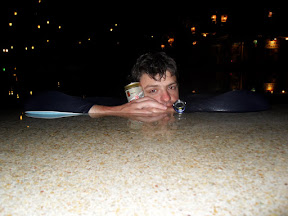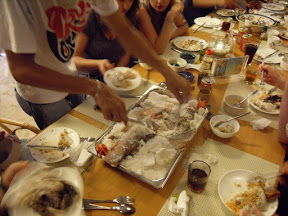He was learning to swim in a monofin at that time and didn't need them. The fins were too large for me and felt loose on my feet, so I attached them to my feet with rubber bands. That helped and I was not afraid to lose the fins, but the friction of the loose rubber foot pockets on my feet was still pretty uncomfortable. Of our group of beginners, nobody could swim properly in fins because nobody had ever been taught. So, instructor Oksana set off on a task of teaching us.
Table of contents:
The easiest way of fin-swimming looks like this: legs must be stretched
out in a straight line, and the fins must be one line with the legs.
Then slow and very wide leg strokes are done, without bending the
knees. The legs work like scissors. This method is used in vertical
dives and underwater swimming. For swimming on the surface the
technique is similar, but the sweeps are made in only one direction –
from the water surface under the water and back to the horizontal line.
Fins should not breach the surface of the water – slamming fins on the
surface does nothing. At the same time the hands should be stretched in
front of the head to reduce the resistance of the water or,
alternatively, to move like in front crawl swimming style. The
freediving fins had larger surfaces than my own and swimming in them
was harder, but they allowed me to develop a greater speed. I didn't
notice any other fundamental difference. After about half an hour of swimming back and forth, Oksana showed us how to swim dolphin style. Dolphin is a more optimal fin-swimming style – it allows propelling oneself through the water using less force. Therefore, it is used in freediving more widely than traditional style. Moreover, it is the only possible way to swim in a monofin. In dolphin style, a swimmer's legs do not move relative to each other. Instead, the body performs a "wave" that starts from the chest and rolls to the tips of the feet. Of course, it goes without saying that perfecting a technique takes time, but no matter how hard we tried, the result was still uninspiring. After another half hour of our clumsy attempts, we went back to the hotel – to swim in the hotel's pool without fins.
I’ve been swimming for as long as I can remember, but nobody has ever taught me a correct swimming technique. All that I know I learned from watching others do and applying it to myself. Needless to say, I swim – to put it mildly – not entirely correctly. I swim crawl ok. I found that my breaststroke is satisfactory, too, but for some reason I was spreading my fingers during the stroke and the water was literally slipping between them. But I had absolutely no idea how to swim dolphin style. I just did not understand what I needed to do with my hands and legs to move forward. Having looked at my suffering, Oksana told me to try to swim a "two-stroke" dolphin: this is when the legs move as in dolphin and the hands as in crawl. But again – nothing good came out of it. There was absolutely no coordination of movements between my hands and legs; the legs were doing something on their own, and the hands were also by themselves. However, after half an hour of swimming back and forth, something started to come together. By that time everybody was very tired, and a lunch was declared. After the lunch we were going to do deep-diving without fins.
That time a wetsuit was not necessary. So instead of it I put on my stinger suit – a full-body Lycra suit. It does not warm, but it protects from the sun and jellyfish stings. Getting into water just in swimming trunks with unprotected skin is not a very good idea in the Philippines at that time of the year – the water is full of plankton and jellyfish that sting. Most stings resemble mosquito bites, but one of our guys was stung by something pretty badly: highly visible burns on his legs took a few days to heal.
Divers use weights to compensate for the wetsuit's buoyancy. For example, I attached 2 kg of weight to my belt when diving in a 3mm suit, which I borrowed at the hotel. That time the weights were not needed, since we dived without the wetsuits. Led by Julia, our team swam to the buoy, which was already set for us beyond the reef. The technique of depth diving without fins is effectively a breaststroke with minor modifications. It begins with a stroke with the hands, and it is much longer than in normal breaststroke: the arms are stretched down almost to the knees rather than stopping at the chest level. The human body has a positive buoyancy, and shoving ourselves down through the water column without the aid of fins is very difficult, hence powerful and long hand strokes are necessary. After the stroke, arms are returned back and stretched above the head. A leg stroke follows, then the whole body is stretched into a straight line and for a few moments glides through the water. Then the arms do their strokes again, and so on.
We started trying, and I resumed my fight with the rope. A freediver needs to "dive in", i.e., to begin the dive, so that the rope is directly in front his eyes. Otherwise, since we do not look down, seeing where we swim is nearly impossible. In my case, I had a rope appearing anywhere but in front of me. In addition, my arm strokes weren't powerful enough and couldn't push me through the water. Equalising pressure in the ears was also a problem.When we dive in fins, one hand is stretched over the head, and the other one immediately goes to the nose. Therefore, we can equalise at any time. When diving without fins, however, both hands do strokes, and that makes pinching the nose and equalising harder. All in all, I did not do very well and did not dive deep, which is understandably due to my lack of technique. Our diving session didn't last long, because a few people were just in swimming trunks and bathing suits. Jellyfish and plankton made that an unpleasant experience for them, and they asked for a permission to go ashore. Upon returning to the hotel, I grabbed a can of beer, got into the pool, and enjoyed a well-deserved relaxation after a hard day.
A bit later our spearfishers came back and brought two big fish, which were immediately roasted and served for a dinner and turned out to be delicious. The dinner was followed by drinks. Somehow, Moscow freedivers prefer rum to all other drinks. A couple of hours later I went back to my hotel, as it was already too late and a high tide was approaching. Contrary to my concern, I was so tired after the hard day that I fell asleep immediately.
The end of the fourth day.
The text and the photos © 2010 Sergey Stadnik












1 comment:
bahahaha, funny with your hands and legs incoordination.
jellyfish stings are common occurrence in moalboal. we never dive there without full gear on! by that I mean with rashguard, gloves, hood, and ordinary socks so we're completely covered!
Post a Comment